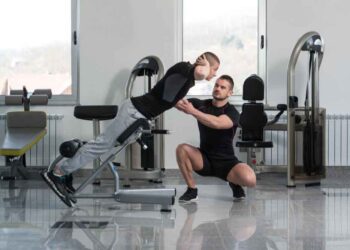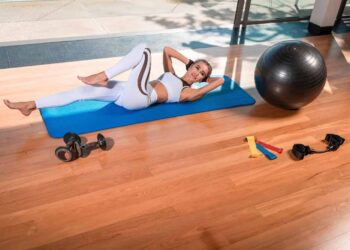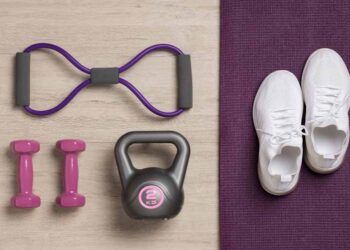Did you know that over 50% of adult women over 50 have low bone mass, putting them at risk for osteoporosis? It’s a startling statistic that highlights the importance of taking proactive steps to support our bone health. One such strategy that has been scientifically proven to be effective is walking.
Walking is not only an enjoyable and accessible form of exercise, but it also offers numerous benefits for bone health. Research has shown that walking can improve bone density and reduce the risk of fractures. In fact, a study found that women who walk more than 7.5 miles per week have higher bone density than those who walk less than one mile per week.
But how exactly does walking improve bone density? And what other exercises can complement its benefits for bone health? In this article, we’ll explore the science behind walking as a bone-strengthening exercise and the role of other exercises in promoting strong and healthy bones.
Key Takeaways:
- Over 50% of adult women over 50 have low bone mass, making bone health a significant concern.
- Walking has been scientifically proven to improve bone density and reduce the risk of fractures.
- Adding balance exercises and walking at a slower pace can further enhance the benefits for bone health.
- While walking is great for bone health, it can be complemented with yoga, strength training, and balance training for maximum benefit.
- Weight-bearing exercises, like brisk walking, are crucial for improving bone health, while non-weight-bearing exercises do not provide the same bone-strengthening benefits.
How Walking Improves Bone Density
Walking is a rhythmic, dynamic, and aerobic activity that offers numerous benefits for bone health. As a weight-bearing exercise, it strengthens the major muscle groups of the legs, limb girdle, lower trunk, and shoulders, providing a natural stimulation for bone growth and density. When you walk, the bones in your legs and spine bear weight, triggering a response from the osteoblasts, the cells responsible for building bones.
Research has shown that regular walking can be effective in preventing bone loss, especially in premenopausal women. Aim for at least 30 minutes of brisk walking, three or more times per week, to reap the maximum bone health benefits. By engaging in this activity, you are encouraging your bones to grow stronger with each step and reducing the risk of bone-related issues.
The Role of Balance Exercises
Incorporating balance exercises while walking can further enhance its impact on bone density. By walking at a slower pace with longer periods of weight-bearing on one foot, you target specific areas like the femur, promoting bone growth and improving bone density in these regions.
“Walking is a fantastic exercise that stimulates the growth of osteoblasts and promotes bone density.” – Dr. Emily Carter, Bone Health Specialist
Incorporating balance exercises into your walking routine not only helps improve bone density but also enhances overall stability and mobility, reducing the risk of falls and fractures.
By making walking a regular part of your exercise regimen and incorporating balance exercises, you can strengthen your bones, improve bone density, and promote optimal bone health.
The Role of Other Exercises in Bone Health
While walking is an excellent exercise for bone health, it can be supplemented with other forms of exercise to further enhance bone density. Incorporating a combination of these exercises into a well-rounded exercise routine can maximize the benefits for bone health.
Strength Training for Bone Health
Strength training exercises, such as weightlifting, resistance band exercises, and bodyweight exercises, strengthen muscles and put stress on bones, stimulating them to become stronger. These exercises promote bone remodeling and the production of new bone tissue. Including strength training in your exercise routine can help improve bone density and reduce the risk of osteoporosis.

Exercise for Bone Density
Incorporating exercises that specifically target bone density can further enhance bone health. High-impact exercises like jumping, skipping, and running can stimulate bone formation due to the strong forces exerted on the bones. These activities lead to increased bone density in weight-bearing areas such as the hips, spine, and legs. By adding these exercises to your routine, you can optimize bone density and reduce the risk of fractures.
The Importance of Weight-Bearing Exercises
Weight-bearing exercises play a crucial role in improving bone health. These exercises produce a force on bones that makes them work harder, leading to increased bone density and strength. By engaging in weight-bearing activities, individuals can enhance bone health, prevent bone loss, and decrease the risk of osteoporosis.
Examples of weight-bearing exercises include:
- Brisk walking
- Jogging or running
- Playing tennis or racket sports
- Climbing stairs
- Dancing
Engaging in these activities stimulates bone growth and density, making bones stronger and more resistant to fractures. Weight-bearing exercises are especially beneficial for individuals at risk of osteoporosis.
It’s important to note that non-weight-bearing exercises like swimming or cycling, while offering other health benefits, do not provide the same bone-strengthening benefits as weight-bearing exercises. These activities don’t subject the bones to the necessary stress required for stimulating bone growth and density.
The Impact of Weight-Bearing Exercises on Bone Health
Weight-bearing exercises promote bone health in several ways:
- Stress on bones: Weight-bearing exercises put stress on bones, forcing them to work harder and adapt to increased loads. This stress stimulates the activity of osteoblasts, the cells responsible for building new bone tissue.
- Increased bone density: Regular weight-bearing exercises promote bone formation, leading to increased bone density. Stronger bones are less likely to fracture and are more resilient against the effects of aging.
- Muscle strengthening: Weight-bearing exercises also strengthen the muscles surrounding the bones. Strong muscles provide additional support and protection to the bones, further reducing the risk of fractures.
By incorporating weight-bearing exercises into your fitness regimen, you can improve bone health, increase bone density, and safeguard against osteoporosis. Remember to consult with a healthcare professional or fitness expert before starting any new exercise program, especially if you have pre-existing health conditions.
Recommended Weight-Bearing Exercises
For individuals looking to prioritize bone health, here are some recommended weight-bearing exercises:
| Exercise | Description |
|---|---|
| Brisk walking | Aerobic exercise that involves walking at a fast pace, engaging the leg and hip joints, and stimulating bone growth in the lower extremities. |
| Jogging or running | High-impact exercises that subject the bones to repetitive stress, stimulating bone remodeling and strengthening the skeletal system. |
| Playing tennis or racket sports | Activities that involve quick directional changes, lunging, and jumping, promoting bone health in the lower body. |
| Climbing stairs | A weight-bearing exercise that helps build bone density in the legs and hips, improving overall strength and stability. |
| Dancing | Various forms of dance, such as ballet, salsa, or hip hop, provide a combination of weight-bearing and dynamic movements, benefiting bone health. |
Recommended Exercise Guidelines for Bone Health
When it comes to maintaining optimal bone health, following exercise guidelines is crucial. Regular exercise plays a vital role in promoting strong and healthy bones, reducing the risk of fractures, and maintaining overall bone density. Here are the recommended exercise guidelines for bone health:
- Aim for at least 150 minutes (2.5 hours) of moderate-intensity exercise or 75 minutes of vigorous-intensity exercise each week. This should include activities that get your heart rate up and make you break a sweat, such as brisk walking, jogging, dancing, or cycling.
- Incorporate muscle-strengthening exercises at least twice a week. These exercises can include weightlifting, resistance band exercises, bodyweight exercises, or using weight machines at the gym. Focus on targeting the major muscle groups, such as the legs, arms, chest, back, and core.
- Include balance training exercises to improve stability and prevent falls, especially for older adults. Balance exercises can involve activities like standing on one leg, practicing yoga poses that challenge balance, or using stability balls or balance boards.
- Consult with a healthcare provider before starting any exercise program, especially if you have chronic health conditions, disabilities, or if you are pregnant. They can provide personalized guidance based on your specific needs and circumstances.
By following these exercise guidelines for bone health, you can ensure that you are engaging in activities that promote strong bones and reduce the risk of osteoporosis. Remember, consistency is key when it comes to reaping the long-term benefits of exercise for bone health.
Additionally, incorporating a well-rounded exercise routine that includes aerobic activity, muscle-strengthening exercises, and balance training can maximize the benefits for bone health. It is important to find activities that you enjoy and can sustain in the long term, as adherence to the exercise program is essential for optimal results.

Seeking Professional Guidance
If you have specific concerns or conditions that require extra attention, consulting with a qualified exercise specialist, physical therapist, or registered dietitian with expertise in bone health can provide valuable guidance. They can create a personalized exercise plan tailored to your unique needs and help you make informed decisions to support your bone health journey.
| Exercise Guidelines for Bone Health | Moderate-Intensity Exercise | Vigorous-Intensity Exercise |
|---|---|---|
| Frequency | At least 150 minutes per week | At least 75 minutes per week |
| Examples | Brisk walking, dancing, cycling | Jogging, aerobic classes, swimming laps |
| Muscle-Strengthening | At least twice a week | At least twice a week |
| Examples | Weightlifting, resistance band exercises, bodyweight exercises | Weightlifting, resistance band exercises, bodyweight exercises |
| Balance Training | As needed, especially for older adults | As needed, especially for older adults |
| Examples | Standing on one leg, yoga poses, stability ball exercises | Standing on one leg, yoga poses, stability ball exercises |
Conclusion
Walking is a scientifically backed strategy for improving bone health. As a weight-bearing exercise, walking strengthens the major muscle groups and promotes bone growth, making it a valuable addition to any fitness routine. But the benefits of walking for bone health don’t stop there. When combined with other exercises such as yoga, strength training, and balance training, walking can maximize the benefits for bone density and reduce the risk of fractures.
It is important to follow recommended exercise guidelines to maintain and enhance bone health throughout life. Incorporating a well-rounded exercise routine that includes both aerobic and resistance training is key. By adopting these strategies and incorporating regular walking into your daily routine, you can strengthen your bones and promote overall well-being.
Don’t underestimate the power of a simple walk. Take a step towards stronger bones today by making walking a part of your exercise routine. Remember, taking care of your bones is an investment in your long-term health and quality of life.












